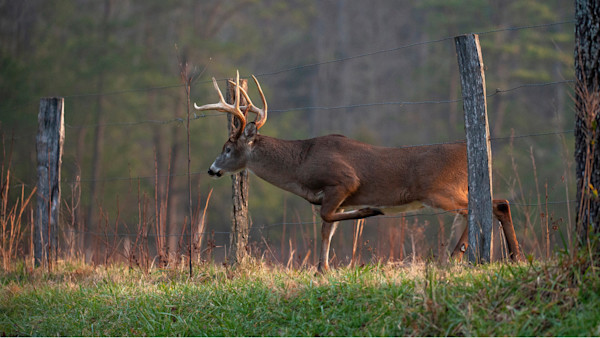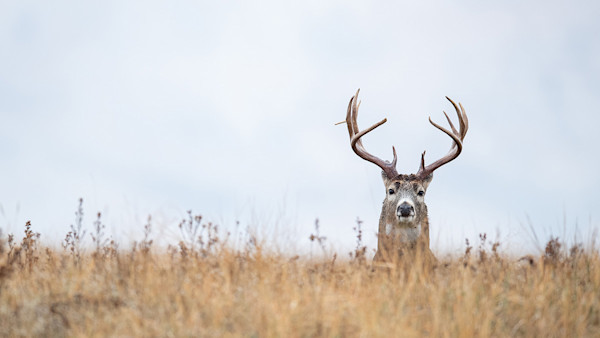
Whitetail deer might be one of the most adaptable species in North America. From the suburbs to the backcountry, whitetail can scratch out a living seemingly anywhere. While many whitetail hunters seek out idealistic habitat littered with large ag fields, food plots, flowing creeks, and ample hardwood timber, it’s important to consider that they are opportunistic animals and can survive solely on grasses and browse, far from postcard whitetail habitat.
For those hunting public land, the biggest obstacle is often hunting pressure. Because of this, mature deer will take refuge in places where they are least bothered by hunters. One key to consistent public land success is learning to identify public land sanctuaries.
Large Parcels Picture a 500-acre chunk of state land composed of rolling hills, dense timber, grassy meadows, and bordered on three sides by large agricultural fields. Most hunters are going to head straight for the field edges and focus on these areas due to the presence of food. The field edges closest to the road are naturally going to see the most human disturbance. The remaining hunters who take to the inner-most parts of the property will likely hunt places that are easily accessible, whether by hiking trail, closed road, or off-trail through moderate terrain.
Assuming this land-use pattern remains true, it is then fairly easy to identify areas least likely to see public hunting pressure. For these reasons I tend to gravitate toward property boundaries and the secluded corners of public land. It’s all too common for hunters to dismiss the corners and oddly shaped edges of properties. My philosophy is that other hunters have already scouted the most productive looking areas and don’t bother going out of their way to check out that 10-acre corner that doesn’t look any different from the remaining 490 acres.
It's sort of like that old fishing adage: 90% of the fish are found in 10% of the water. Similarly, it seems like 90% of hunters sit on the field edges and creek bottoms that are easy to access. You can get away from the crowds diving into the far boundaries of large public pieces.
Small Parcels When I begin planning my upcoming whitetail season I like to seek out small parcels of public land. Think of it this way, when guys and gals are scouting new places to hunt, are they going to gravitate toward the 1,000-acre game production area or the 20-acre piece of state land? Naturally, their eyes are going to gravitate to the big, blue-colored area on their onX map. Much like the corner theory mentioned above, not many hunters are going to give this small property the time of day.
Similarly, when hunters are looking for a new piece of public land to access, they typically favor properties that are close to home. For this reason, I generally dismiss hunting public lands that are near large metropolitan areas. That is, unless the piece of public is large enough for hunters to spread out and dilute the hunting pressure. Isolated pieces of public land always catch my eye. Very few hunters are going to make a 2-hour drive to a county with very little public land when they can make an hour drive to a county with abundant public land.
Irregularities Another way to find a diamond in the rough is to target properties that simply don’t look good from the human lens. For example, think of picturesque whitetail habitat. In a state or county that has prime whitetail habitat everywhere you look, who’s going to spend time hunting that little slough with only a dozen trees?
The same applies to CRP fields that look much more conducive to pheasant and duck hunters than whitetail hunters. This philosophy can also be applied to the thin timber strips that couldn’t hide a field mouse but connects two large pieces of prime whitetail woods. These irregular properties might not look great from the road but will often result in you being the only hunter in the woods.
Difficult Access If all else fails, sometimes you just need to be willing to work harder than the next guy. This often means accessing areas that other hunters are simply unwilling to go. In highly pressured areas the equation is simple: Find places that other hunters don’t find appealing and you will likely find deer.
To locate these areas, look for some sort of barrier that is likely to make public hunting access difficult. This barrier may come in the form of terrain, vegetation, water, or property boundaries. In the Midwest, flatlanders will generally avoid abnormally large hills or ravines. Rivers, creeks, lakes, and sloughs also commonly present a barrier to entry that many hunters aren’t equipped for. In other instances, funky property boundaries that require hunters to get creative or take the long route can create hard to access areas. As a last resort, if you aren’t able to work smarter, sometimes you just have to work harder and hike your gear to the deepest corner of the property.
It is no secret that quality deer hunting requires food, water, and cover. Because deer are so adaptable, satisfying the need for food and water can be easily obtained. Often, however, the missing component on public land is sanctuary. For this reason, you can use hunting pressure to your advantage. The deer are seeking sanctuary and so should you.
Feature image via Matt Hansen.









Conversation